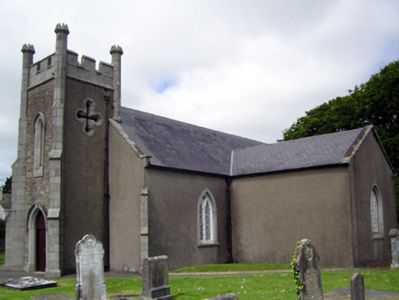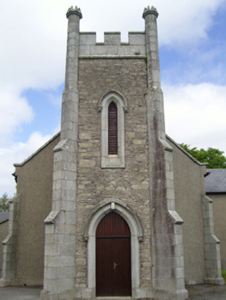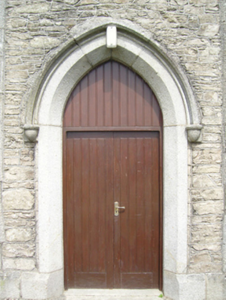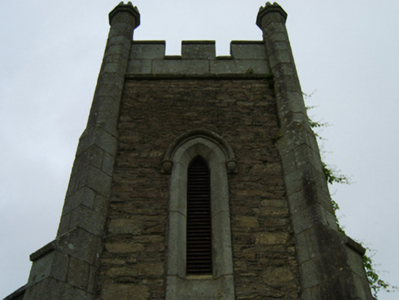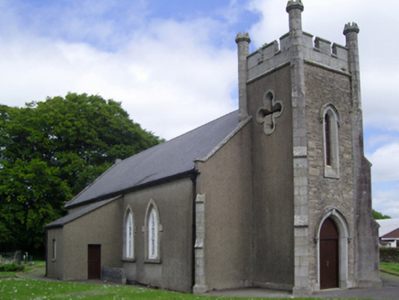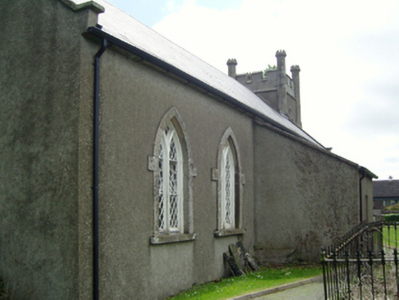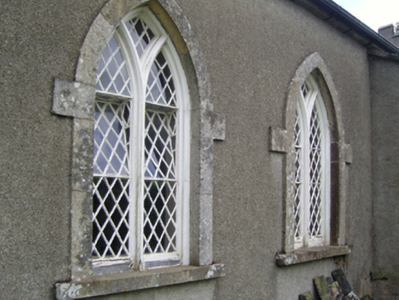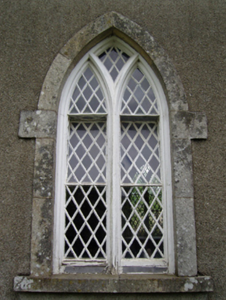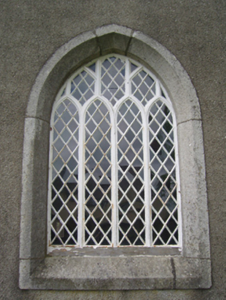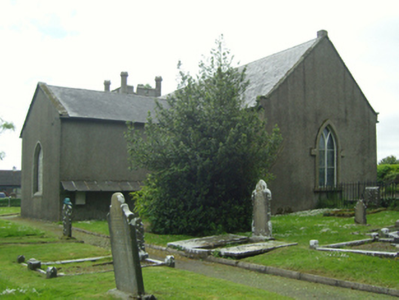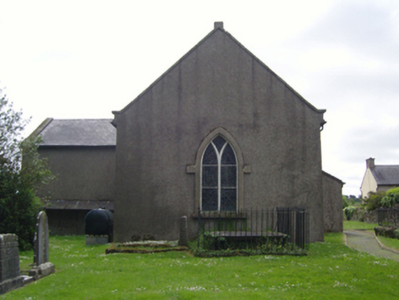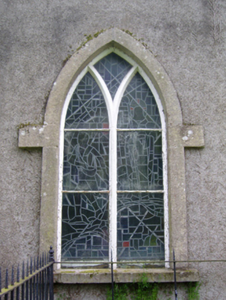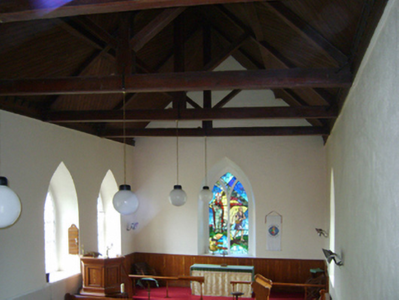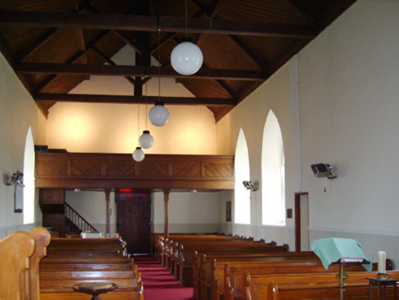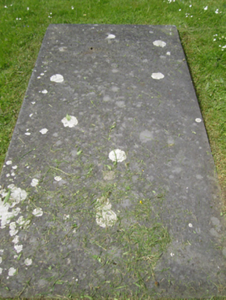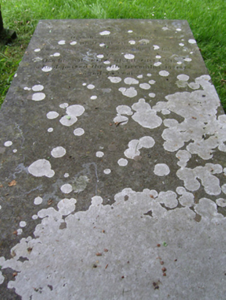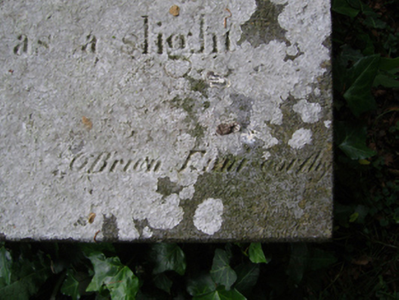Survey Data
Reg No
15609005
Rating
Regional
Categories of Special Interest
Architectural, Artistic, Historical, Scientific, Social, Technical
Original Use
Church/chapel
In Use As
Church/chapel
Date
1820 - 1825
Coordinates
306660, 152779
Date Recorded
08/03/2007
Date Updated
--/--/--
Description
Detached three- or five-bay double-height Board of First Fruits Church of Ireland church, rebuilt 1823, on a T-shaped plan comprising three- or five-bay double-height nave opening into single-bay (single-bay deep) double-height transept (east) with single-bay two-stage tower to entrance (south) front on a square plan. Renovated, 1858, with interior "improved". Reroofed, 2004. Replacement pitched slate roof on a T-shaped plan with ridge tiles, moss-covered cut-granite coping to gables on roughcast kneelers, and uPVC rainwater goods on slate flagged eaves retaining cast-iron octagonal or ogee hoppers and downpipes. Fine roughcast battered walls with granite ashlar diagonal stepped buttresses to corners having lichen-covered cut-granite coping; fine roughcast surface finish to tower on benchmark-inscribed cut-granite chamfered plinth with battlemented octagonal pinnacle-topped granite ashlar diagonal stepped buttresses to corners centred on granite ashlar parapets having cut-granite coping. Pointed-arch window openings with cut-granite sills, carved timber Y-mullions, and cut-granite block-and-start surrounds framing fixed-pane fittings having cast-iron lattice glazing bars. Pointed-arch window opening to transept (east) with carved timber mullions, and cut-granite surround having chamfered reveals framing fixed-pane fittings having cast-iron lattice glazing bars. Pointed-arch window opening to chancel (north) with cut-granite sill, carved timber Y-mullion, and cut-granite block-and-start surround framing fixed-pane fittings having leaded stained glass panels. Pointed-arch door opening to tower with cut-granite threshold, and cut-granite surround having chamfered reveals with hood moulding over on label stops framing replacement timber boarded or tongue-and-groove timber panelled double doors having overpanel. Lancet opening (bell stage), cut-granite surround having chamfered reveals with hood moulding over on label stops framing louvered timber fitting. Cruciform "Balistraria" to "cheeks" with cut-granite surrounds having chamfered reveals. Interior including vestibule (south); square-headed door opening into nave with timber boarded or tongue-and-groove timber panelled door having overlight; full-height interior open into roof "improved", 1858, with diagonal timber boarded or tongue-and-groove timber panelled choir gallery (south) on chamfered timber pillars, carpeted central aisle between timber pews, polished brass wall monuments (ob. 1905; 1918) with cut-white marble Classical-style wall monuments (ob. 1856; 1874), timber panelled pulpit on an octagonal plan with timber clerk's desk, carpeted stepped dais to chancel (north) with turned timber balusters supporting carved timber communion railing centred on cloaked altar (1915) below stained glass memorial "North Window" (1962), and exposed strutted King post timber roof construction with wind braced diagonal timber boarded or tongue-and-groove timber panelled ceiling on carved timber cornice. Set in landscaped grounds with roughcast piers to perimeter having cut-granite shallow pyramidal capping supporting cast-iron double gates.
Appraisal
A church reconstructed with financial support from the Board of First Fruits (fl. 1711-1833) representing an important component of the ecclesiastical heritage of County Wexford with the architectural value of the composition, 'a plain small structure' repurposing a later eighteenth-century church erected (1772-5) to an anonymous design (Leslie 1936, 248), confirmed by such attributes as the nave-with-entrance tower plan form, aligned along a liturgically-incorrect axis; the "pointed" profile of the openings underpinning a contemporary Georgian Gothic theme with the chancel defined by a restrained "North Window"; and the polygonal pinnacles embellishing the tower as a picturesque eye-catcher in the landscape. Having been well maintained, the elementary form and massing survive intact together with substantial quantities of the original fabric, both to the exterior and to the interior "improved" to a design by Joseph Welland (1798-1860), Architect to the Ecclesiastical Commissioners (appointed 1843; RCB), where contemporary joinery; restrained wall monuments; and the vibrant Pinnions-Roark Memorial "North Window" produced (1962) by Irish Stained Glass (established 1957) of Dublin, all highlight the artistic potential of the composition: meanwhile, an exposed timber roof construction pinpoints the engineering or technical dexterity of a church making a pleasing visual statement in a rural village street scene.

